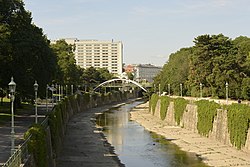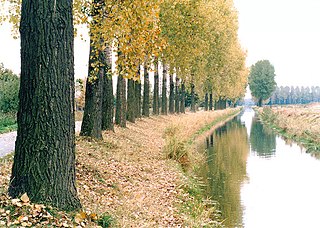
The Aller is a 215-kilometre-long (134 mi) river in the states of Saxony-Anhalt and Lower Saxony in Germany. It is a right-hand, and hence eastern, tributary of the Weser and is also its largest tributary. Its last 117 kilometres (73 mi) form the Lower Aller federal waterway. The Aller was extensively straightened, widened and, in places, dyked, during the 1960s to provide flood control of the river. In a 20-kilometre-long (12 mi) section near Gifhorn, the river meanders in its natural river bed.
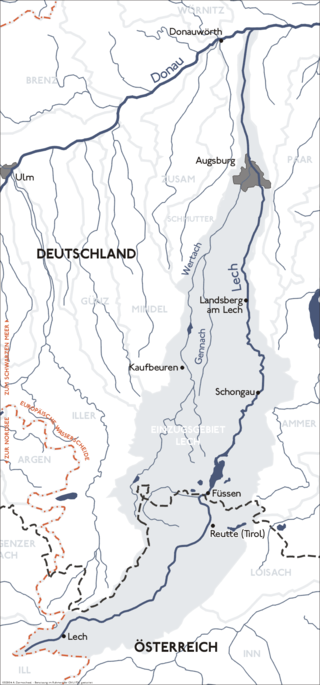
The Lech is a river in Austria and Germany. It is a right tributary of the Danube 255 kilometres (158 mi) in length with a drainage basin of 3,919 square kilometres (1,513 sq mi). Its average discharge at the mouth is 115 m3/s (4,100 cu ft/s). Its source is located in the Austrian state of Vorarlberg, where the river rises from lake Formarinsee in the Alps at an altitude of 1,870 metres (6,120 ft). It flows in a north-north-easterly direction and crosses the German border, forming the Lechfall, a 12-metre-high (39 ft) waterfall; afterwards the river enters a narrow gorge. Leaving the Alps, it enters the plains of the Allgäu at Füssen at an elevation of 790 metres (2,580 ft) in the German state of Bavaria, where it used to be the location of the boundary with Swabia. The river runs through the city of Füssen and through the Forggensee, a man-made lake which is drained in winter. Here, it forms rapids and a waterfall.

The Kostroma is a river in the European part of Russia. It flows through the Kostroma and Yaroslavl Oblasts, and becomes a left tributary of the Volga, which it enters at the Gorky Reservoir, at the city of Kostroma.

The Timiș or Tamiš is a 359-kilometre-long (223 mi) river that flows through the Banat region of Romania and Serbia and joins the Danube near Pančevo, in northern Serbia. Due to its position in the region, it has been labeled as the "spine of the Banat".
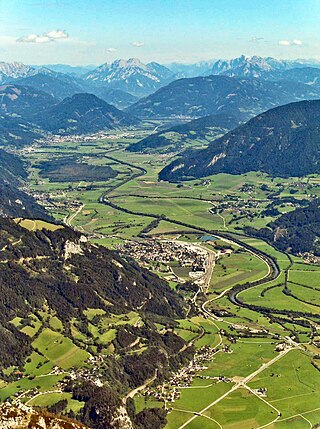
The Enns is a southern tributary of the river Danube, joining northward at Enns, Austria. It forms much of the border between the states of Lower Austria and Upper Austria. The Enns spans 253 kilometres (157 mi), in a flat-J-shape. It flows from its source near the village Flachau, generally eastward through Radstadt, Schladming, and Liezen, then turns north near Hieflau, to flow past Weyer and Ternberg through Steyr, and further north to the Danube at Enns.
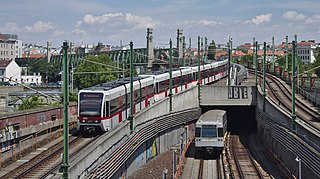
The Vienna U-Bahn, where U-Bahn is an abbreviation of the German word Untergrundbahn, is a rapid transit system serving Vienna, Austria. The five-line network consists of 83.1 kilometers (51.6 mi) of route, serving 109 stations. 459.8 million passengers rode the U-Bahn in 2019. The network is undergoing expansion and rolling stock renewal. Since 1969, 200 million euros have been invested annually in the extension of the Vienna U-Bahn.
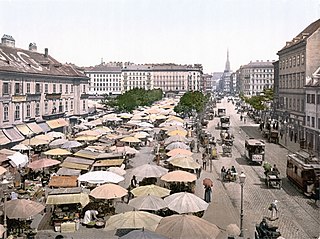
The Naschmarkt is Vienna's most popular market. Located at the Wienzeile over the Wien River, it is about 1.5 kilometres (0.93 mi) long.

The Sulm is a river in the Heilbronn district of Baden-Württemberg, Germany. It is an unnavigable right tributary of the Neckar. It rises in the Löwenstein Mountains and after 26.3 kilometres (16.3 mi) distance and 315 metres (1,033 ft) elevation drop flows into the Neckar at Bad Friedrichshall, near Untereisesheim and Neckarsulm. Its valley together with its tributary valleys is also known as the Weinsberg Valley, after Weinsberg, which is located there. The medieval region of Sulmgau, as well as the city of Neckarsulm, were named for it. The upper valley of the Sulm is a protected area.
The Wienzeile is a street in Vienna, which originated in the course of the regulation of the Vienna River between 1899 and 1905 along the river's banks.

The Vienna Danube regulation refers to extensive flood-control engineering along the Danube river in Vienna, Austria during the last 150 years. The first major dams or levees were built during 1870-75. Another major project was constructed during 1972-88, which created the New Danube and Danube Island (Donauinsel). Prior to regulation, the Danube in Vienna had been an 8-kilometre (5 mi) wide wetlands, as a patchwork of numerous streams meandering through the area.

The Danube is the second-longest river in Europe, after the Volga in Russia. It flows through Central and Southeastern Europe, from the Black Forest south into the Black Sea. A large and historically important river, it was once a frontier of the Roman Empire. In the 21st century, it connects ten European countries, running through their territories or marking a border. Originating in Germany, the Danube flows southeast for 2,850 km (1,770 mi), passing through or bordering Austria, Slovakia, Hungary, Croatia, Serbia, Romania, Bulgaria, Moldova, and Ukraine. Among the many cities on the river are four national capitals: Vienna, Bratislava, Budapest, and Belgrade. Its drainage basin amounts to 817,000 km² and extends into nine more countries.

For a long time, it was not necessary to build a Harbour in Vienna, because the existing natural landing points were sufficient for the level of trade on the Danube. It was only when steamships began to arrive in great numbers that a harbour offering safe berths became essential. Even then however, goods were for the most part loaded and unloaded at an unenclosed river harbour that was established at the end of the 19th century.

The hydrology of Hungary, is mostly determined by Hungary's lying in the middle of the Carpathian Basin, half surrounded by the Carpathian Mountains. All parts of the country have some outflow. All surface water gravitates towards its southern center, and from there, is united in the Danube, which flows into the Black Sea. The whole of Hungary lies within the Danube drainage basin.

The Schwarza is a river in Lower Austria. It is the left headstream of the Leitha.
Pilgramgasse is a station on the Vienna U-Bahn line U4. It is located in Margareten between Ramperstorffergasse and the eponymous street, which is named after Franz Anton Pilgram (1699–1761), an Austrian Baroque architect. The station is in an open cut parallel to the River Wien and curves to match the curve of the river.

The Ablach is a right tributary of the Danube. It rises on the European Watershed, which is only a hint in this area, from the Mindersdorfer Aach in the municipality of Hohenfels in the Landkreis of Konstanz. It is about 32 kilometres (20 mi) long.
Kosasthalaiyar River, also known as Kortalaiyar, is one of the three rivers that flow in the Chennai metropolitan area.

The Schwechat is a river in Lower Austria. Its drainage basin is 1,182 km2 (456 sq mi).
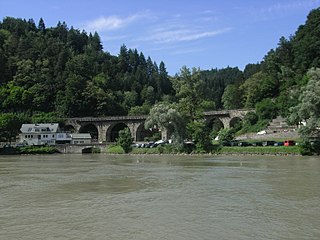
The Gießenbach is a river of Austria. Its drainage basin is 64 km2 (25 sq mi).
The Riverin River is a river in the Côte-Nord region of the province of Quebec, Canada. It is a tributary of the Gulf of Saint Lawrence. There is a small hydroelectric power plant near the mouth of the river.
